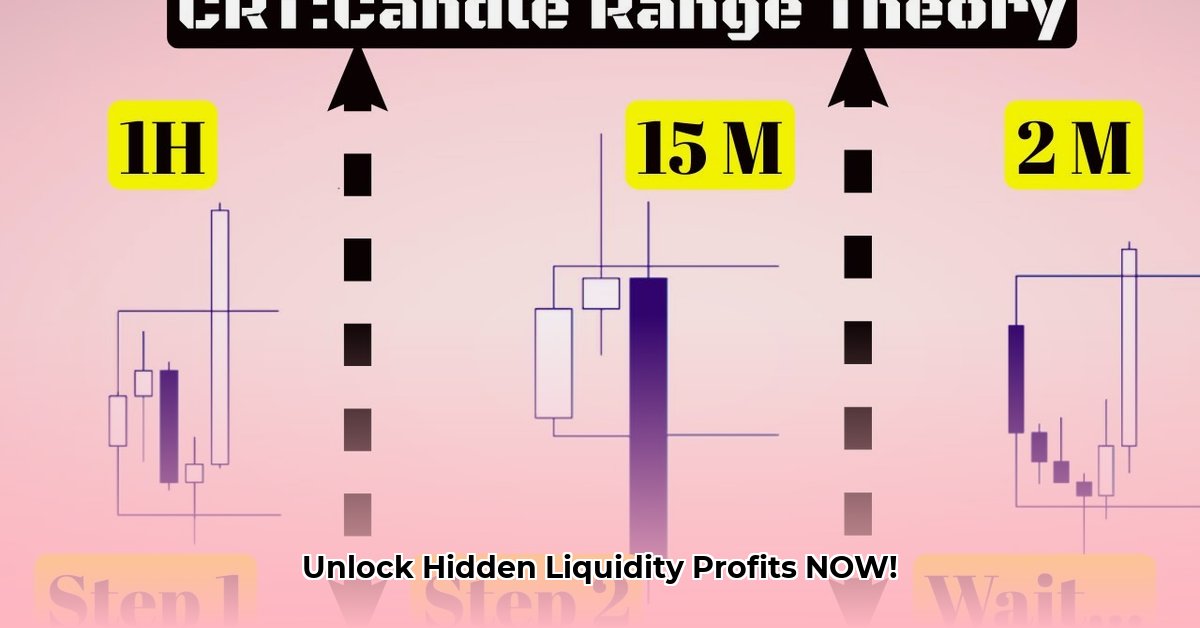
Understanding the Candle Range Theory (CRT) Trading Strategy
The Candle Range Theory (CRT) is a trading strategy built upon established principles of Intraday Charting Techniques (ICT). It leverages candlestick patterns to identify potential price reversals by pinpointing areas of concentrated market orders—essentially, where significant buying or selling pressure has exhausted itself. This strategy aims to capitalize on the subsequent price pullback or bounce. But does it deliver on its promise? Let's delve deeper. Understanding CRT's core principles is crucial before even attempting to use it. For more on liquidity in trading, see this helpful resource list.
Identifying CRT-High and CRT-Low Setups
CRT hinges on two primary setups:
- CRT-High (Bearish): A bearish signal identified by price action absorbing liquidity above the previous candle's high before reversing downwards. This indicates a temporary peak before a potential price decline.
- CRT-Low (Bullish): The opposite of CRT-High. A bullish signal where the price action absorbs liquidity below the previous candle's low, then reverses upwards. This signifies a temporary dip before a potential price rally.
Identifying these setups is only the first step. Successfully using the CRT strategy requires confirmation from other technical indicators and a solid understanding of the broader market context.
Crucial Confirmation Signals and Broader Market Analysis
While CRT-High and CRT-Low provide initial clues, confirmation is paramount. Combining CRT with ICT's Market Structure Shifts (MSS) significantly increases the probability of a profitable trade. MSS analysis can validate the identified liquidity grab and strengthen the prediction of an upcoming reversal.
Furthermore, contextual analysis of the broader market trend and sentiment is vital. Ignoring the overall market picture can lead to significant losses, even with a seemingly perfect CRT setup.
A Step-by-Step Guide to Implementing the CRT Strategy
Here's a practical, numbered guide on implementing the CRT Strategy:
- Identify Potential Setups: Meticulously examine price charts for potential CRT-High or CRT-Low formations. Patience is key; avoid rushing this crucial initial assessment.
- Cross-Verify with ICT Signals: Employ additional ICT tools, such as MSS, to confirm the identified signal. The more confirming signals you have, the higher the confidence level.
- Assess the Broader Market Context: Analyze the overarching market trend and prevailing sentiment. A strong uptrend makes a bullish CRT setup more probable, while a downtrend favors a bearish setup.
- Determine Precise Entry and Exit Points: Establish clear entry and exit points using support/resistance levels, and, crucially, utilize stop-loss orders to limit potential losses.
- Monitor and Adapt: Continuously monitor active trades, and adapt your strategy as market conditions change. Remember, the market is dynamic, and rigid adherence to a single plan often leads to failure.
Does this mean confirmation signals remove all risk? Absolutely not. The market's inherent uncertainty means no signal is foolproof.
Risk Management: A Realistic Assessment of CRT Trading
Trading involves risk, and CRT is no exception. Several key risk factors must be considered:
- False Signals: CRT setups don't always result in profitable trades. Confirmation is critical in mitigating this risk.
- Market Volatility: Sudden price swings can significantly impact trading outcomes. This highlights the importance of robust position sizing and stop-loss orders.
- Over-Optimization: Avoid tailoring your strategy solely to past data. Thorough testing with independent data is essential to avoid misleading results.
- Ignoring Market Context: Failing to understand broader market dynamics can negate all other elements of the strategy.
The following table summarizes these risks and recommended mitigation strategies:
| Risk Factor | Likelihood | Impact | Mitigation |
|---|---|---|---|
| False Signals | Moderate | Moderate | Employ multiple confirmation signals; use well-defined rules. |
| Market Volatility | High | High | Implement strict position sizing; always use stop-loss orders. |
| Over-optimization | Moderate | Moderate | Thoroughly backtest your strategy; use out-of-sample data for validation. |
| Neglecting Market Context | High | High | Conduct comprehensive market analysis; stay updated on news and events. |
The Interplay of CRT and ICT: A Synergistic Approach
It's crucial to remember that CRT and ICT are not mutually exclusive; they are complementary. CRT acts as an enhancing layer within the broader ICT framework. Treating CRT as a stand-alone system is short-sighted and significantly increases risk.
Successful trading demands dedication, continuous learning, and strict discipline. Mastering and applying CRT effectively requires patience, thorough understanding of market mechanics, and integrating it into a well-defined, overall trading plan. It's a powerful tool, but not a magic formula.
Backtesting CRT Strategies: A Critical Step
Thorough backtesting is crucial to validate CRT's effectiveness and identify weaknesses. This involves defining clear parameters, establishing objective criteria for signal identification, acquiring high-quality historical data, automating the backtesting process using software, and rigorously analyzing the results. Consider using Python and libraries like pandas and backtrader. Remember, a meticulously designed backtest is invaluable in identifying biases and potential pitfalls. Only through rigorous backtesting can you truly assess CRT's long-term viability.